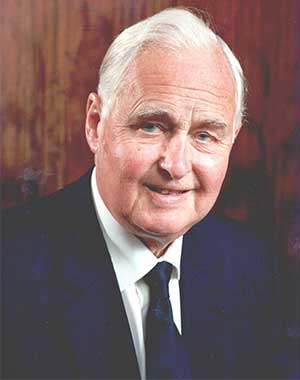William Barlow is best known for his role as Chair of the Post Office and organising its division into two separate corporations, the Post Office and British Telecom (BT). Following a successful career in industry, the Labour government had to work hard to persuade him to become Chair and Chief Executive in 1977. He soon realised that the two parts of the business were so different that they must be split up. The Labour government did not agree, but Sir William decided to press ahead with a major programme of telecom digital switching and optical technology. The new Conservative government elected in 1979 agreed to the split, which he then organised in 12 months. He was then to have been Chair of BT as a privatised company but the Thatcher government refused to privatise it. In 1980 he declined the appointment and returned to the private sector to organise the merger of Thorn and EMI.
In 1984 he became Executive Chair of BICC, one of the world’s largest cable companies, and its subsidiary, construction company Balfour Beatty. He was heavily involved in the concept and construction of the Channel Tunnel.
As Managing Director of English Electric Computers in the 1960s, Sir William was involved in the computing boom in the UK. He pressed for the amalgamation of the UK’s competing computer companies, which led to the formation of ICL in 1968. Within weeks of this, English Electric decided to merge with GEC but Sir William disagreed so strongly with this move that he resigned from the organisation after 21 years' service. He was not alone – many senior people followed him including Lord Caldecote, the Academy’s second President.
The government then asked him to combine the three British strategic bearing companies, which created RHP. He led a programme of modernisation and rationalisation that created a world-class development and manufacturing company.
Never one to hide his views on the importance of British industry, Sir William used his Presidency of the Academy to campaign for investment in transport and environmental infrastructure to support engineering, particularly manufacturing, which he saw as vital to the country’s economic stability. He did much to raise the Academy’s profile within government and industry by promoting engineers’ achievements.

Sir William Barlow
- 1924 Born 8 June in Oldham
- 1944 Following education at Manchester Grammar School, graduates from University of Manchester Institute of Science and Technology with a first-class degree in electrical engineering
- 1944 Joins the Royal Navy, spending three years in minesweeping and clearance
- 1947 Joins the English Electric company electric traction business
- 1950 Manages a large-scale electrification project in northwest Spain for Spanish National Railways
- 1958 Becomes Manager of English Electric’s Canadian operations including hydro-electric projects and turbines for the St Lawrence Seaway
- 1962 Appointed Managing Director of English Electric’s Liverpool operations
- 1968 Appointed Managing Director of English Electric Computers, which forms ICL the following year
- 1970 Becomes Founder Chair and Chief Executive of new ball-bearing company RHP
- 1977 Knighted for services to industry
- 1977 Becomes Chair and Chief Executive of the Post Office
- 1981 Appointed Chair of Thorn EMI Engineering Group
- 1984 Appointed Chair and Chief Executive of cable and construction group BICC
- 1988 Becomes a Founder Non-Executive Director of Vodafone Group
- 1991 Appointed President of the newly renamed Royal Academy of Engineering
- 1992 Becomes Chair of Ericsson UK
- 1997 Becomes Chair of Parsons Brinckerhoff Europe
- 2012 Dies 19 May, aged 87
